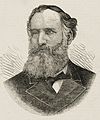New South Wales colonial election, 1891
|
|
|||||||||||||||||||||||||||||||||||||||||||||
|---|---|---|---|---|---|---|---|---|---|---|---|---|---|---|---|---|---|---|---|---|---|---|---|---|---|---|---|---|---|---|---|---|---|---|---|---|---|---|---|---|---|---|---|---|---|
|
|||||||||||||||||||||||||||||||||||||||||||||
|
All 141 seats in the New South Wales Legislative Assembly 71 Assembly seats were needed for a majority |
|||||||||||||||||||||||||||||||||||||||||||||
|
|||||||||||||||||||||||||||||||||||||||||||||

Legislative Assembly after the election
|
|||||||||||||||||||||||||||||||||||||||||||||
|
|||||||||||||||||||||||||||||||||||||||||||||
The 1891 New South Wales colonial election was held between 17 June to 3 July 1891. This election was for all of the 141 seats in the New South Wales Legislative Assembly and it was conducted in 35 single-member constituencies, 20 2-member constituencies, 10 3-member constituencies and nine 4-member constituencies, all with a first past the post system. Suffrage was limited to adult white males. Seven seats that were uncontested. The previous parliament of New South Wales was dissolved on 6 June 1891 by the Governor, The Earl of Jersey, on the advice of the Premier, Sir Henry Parkes.
The election saw the first appearance of the Australian Labor Party (then known as the Labour Electoral League of New South Wales), who took a significant number of votes and seats from both of the previous two major parties in the Assembly, and giving Labour the balance of power. The main political parties in New South Wales, the Protectionist Party and the Free Trade Party both lost seats to Labour, with Parkes' Free Trade government losing office to George Dibbs' Protectionists after Dibbs arranged for support for his government from Labour.
New South Wales colonial election, 3 July 1891
Legislative Assembly
<< 1889 — 1894 >>
...
Wikipedia


